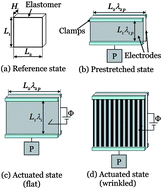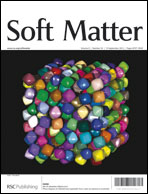Two types of transitions to wrinkles in dielectric elastomers†
Abstract
A membrane of a dielectric elastomer coated with compliant electrodes may form wrinkles as the applied voltage is ramped up. We present a combination of experiment and theory to investigate the transition to wrinkles using a clamped membrane subject to a constant force and a voltage ramp. Two types of transitions are identified. In type-I transition, the voltage–stretch curve is N-shaped, and flat and wrinkled regions coexist in separate areas of the membrane. The type-I transition progresses by nucleation of small wrinkled regions, followed by the growth of the wrinkled regions at the expense of the flat regions, until the entire membrane is wrinkled. By contrast, in type-II transition, the voltage–stretch curve is monotonic, and the entire flat membrane becomes wrinkled with no nucleation barrier. The two types of transitions are analogous to the first and the second order phase transitions. While the type-I transition is accompanied by a jump in the vertical displacement, type-II transition is accompanied by a continuous change in the vertical displacement. Such transitions may enable applications in muscle-like actuation and energy harvesting, where large deformation and large energy of conversion are desired.


 Please wait while we load your content...
Please wait while we load your content...